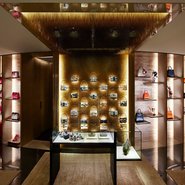- About
- Subscribe Now
- New York,
September 11, 2013

Most luxury buyers do online research before buying, but 65 percent of consumers will buy from a store to touch and feel the product before deciding on it, according to new research from Google.
The “How Affluent Shoppers Buy Luxury Goods: A Global View” report found that even though affluent consumers are tech-savvy, most want to experience a luxury product in person before spending money. Luxury marketers should keep in mind that consumers want to experience a product as much as possible, both online and in stores, before investing in a high-end purchase.
“Something that we found interesting is that despite the fact that most shoppers purchase luxury goods in stores, 75 percent will conduct research online before making that purchase, which goes to show the vital role that digital plays in these decisions,” said Brian Zeug, industry director of branded apparel at Google, New York.
“Since the lion’s share of sales are still happening in the store, it’s easy to discount the importance of online, but this research clearly shows that doing so would be a mistake,” he said.
“Luxury retailers that don’t offer a great online experience for shoppers will miss out on the ability to influence these decisions before a customer even steps foot into the door.”
The “How Affluent Shoppers Buy Luxury Goods: A Global View” report conducted interviews with individuals between the ages of 25-65 who were in the top 5-8 percent of affluent households in nine countries and had made at least two luxury purchases in the past two years. The interviews were conducted on the phone and online January-April 2013.
Old and new
The report found that affluent consumers in new markets such as China, Brazil and Russia are typically younger and are frequent buyers.
In these markets, 56 percent of luxury buyers are female with an average age of 37. The new markets also seem to make the most purchases with an average of almost 23 items purchased per person in the last two years.
Louis Vuitton's Chinese ecommerce site
For the more mature markets such as France, Britain, United States, Italy and Germany, both men and women are making luxury purchases. The average age for buyers in this area is 46 years old and with an average of almost 13 items per person in the last two years.
However, the Japanese vary drastically from both the new and mature markets.
The Japanese average almost three luxury items purchased in the past two years.
In addition, 69 percent of the luxury buyers in Japan have made at least one luxury purchase in the past two years compared to all luxury buyers in new markets and 99 percent in mature markets.
Furthermore, all of the countries surveyed including both mature and new markets spent an average of $2,500 on their most recent luxury purchase.
Online v. offline
Through this research, Google found that most luxury purchases happen offline. Ecommerce and an online presence are still important, especially for product research.
Eighteeen percent of luxury buyers in new markets use ecommerce compared to 61 percent of those buyers who purchase in store.
These results are similar to those buyers in mature markets with 13 percent using ecommerce and 72 percent going into the store.
However, in Japan only 7 percent of buyers are using ecommerce while 78 percent are heading to the stores.
Even though these affluent consumers are going in stores to make their purchases, most of them are doing their research online first.
Balenciaga's ecommerce options
Ninety-two percent of buyers in new markets did online research before making a purchase, compared to 69 percent in mature markets and 49 percent in Japan.
Also, the report found that very few consumers do all of their research and purchasing offline. Six percent of buyers in new markets and 1 percent in mature markets research and purchase products all offline, compared to 42 percent of Japanese consumers.
Burberry's Regent Street store in London
On the other hand, 55 percent of buyers in mature markets, 72 percent in new markets and 39 percent of Japanese do product research online and offline before making a purchase offline.
In addition, 53 percent of luxury buyers around the world said the No. 1 motivating factor for buying online was convenience, while 65 percent said the main barrier to purchasing was that they prefer to see and touch the product.
Since consumers are integrating online and offline methods of shopping, marketers need to create a seamless experience between platforms.
“We’re clearly in a multiscreen world, where shoppers switch seamlessly between online and offline research, smartphone and laptop,” Mr. Zeug said.
“The line between an in-store shopper and online shopper doesn’t exist,” he said.
“The savviest brands are already realizing this and are incorporating digital marketing into a core part of their overall strategy.”
Final take
Erin Shea, editorial assistant on Luxury Daily, New York
Share your thoughts. Click here